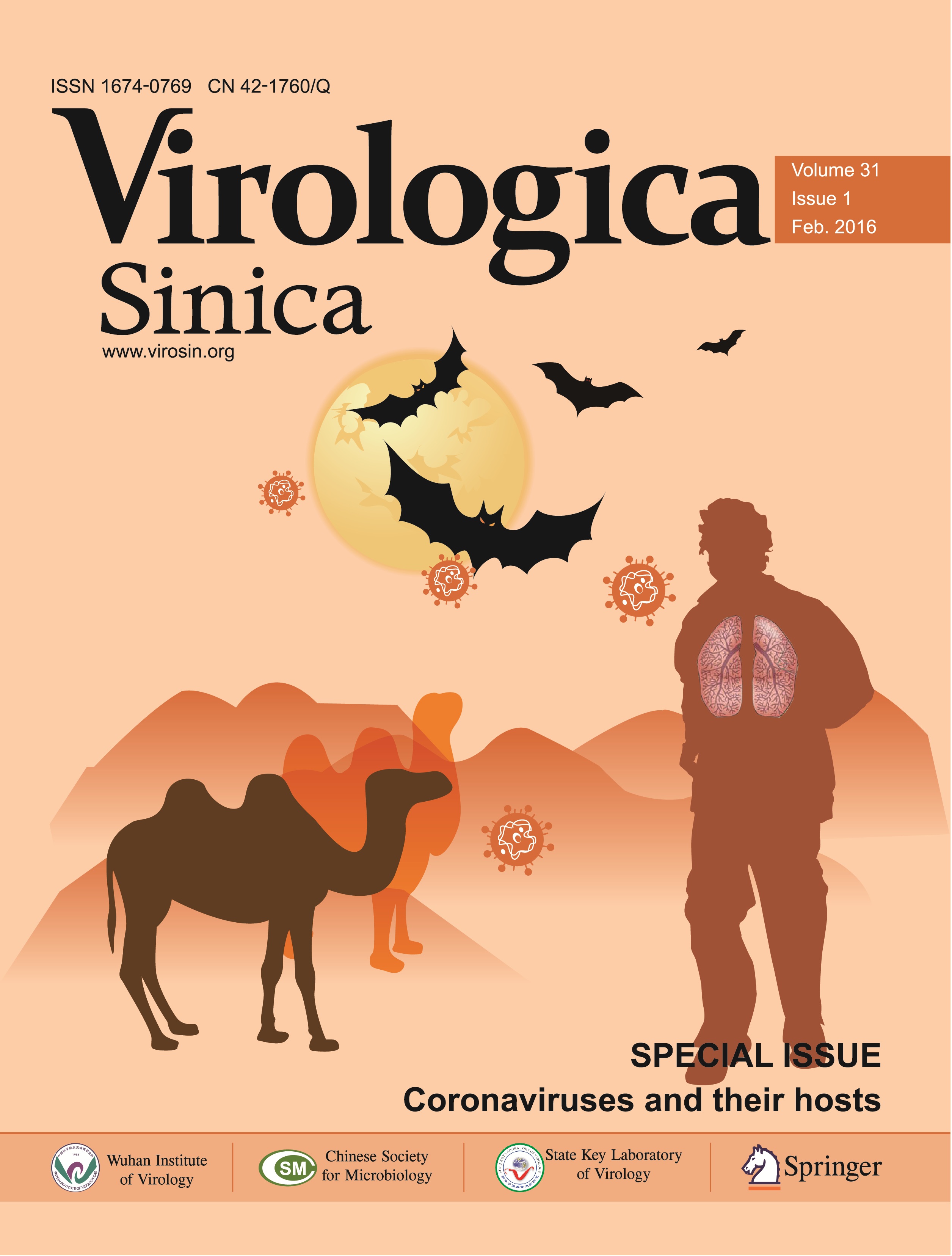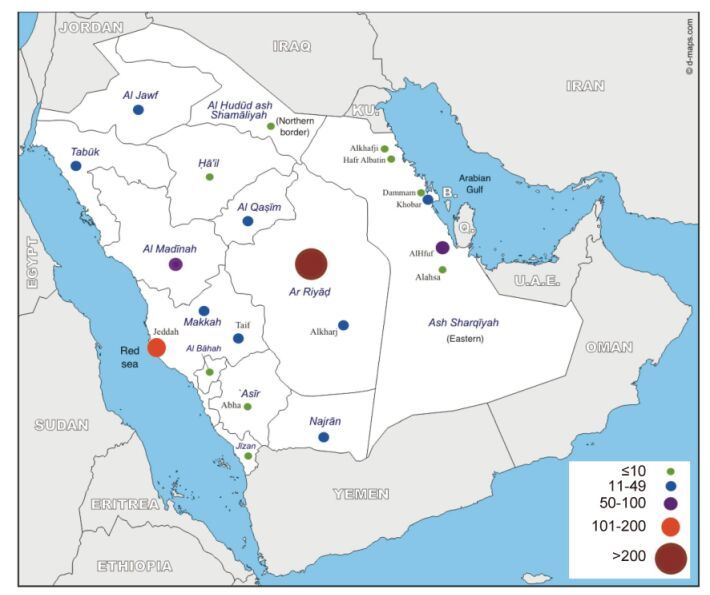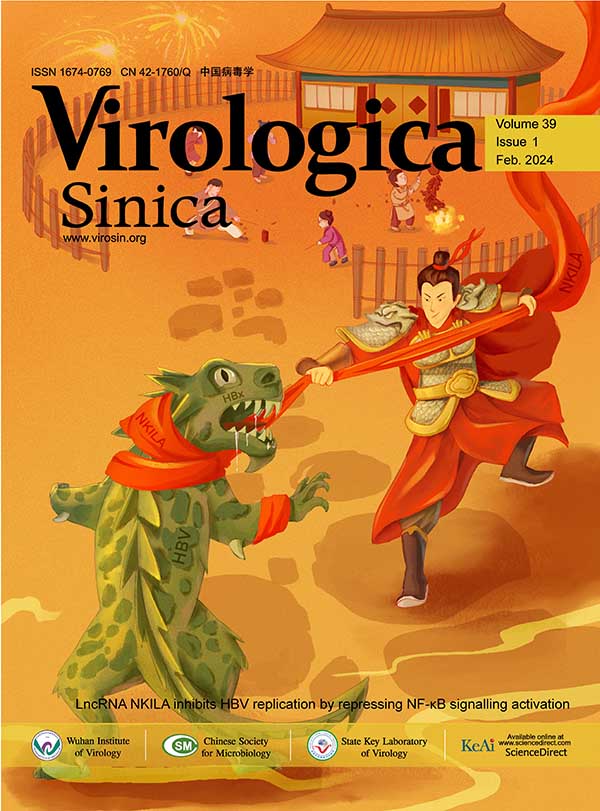Coronaviruses (CoVs) infect a wide range of vertebrates, including humans. They can cause respiratory, gastrointestinal, hepatic and central nervous system diseases. Some CoVs have managed to across the species barrier, such as severe acute respiratory syndrome (SARS)-CoV and Middle East respiratory syndrome (MERS)-CoV. This special issue of Virologica Sinica is dedicated to the recent progress on coronaviruses and covers topics on viral epidemiology, virus replication and the interactions between the coronaviruses and their hosts. This updated information would provide new insights in the control of CoV infections, and in the development of effective antivirals. The cover depicts the modes of transmission of coronavirus from animals to humans.
-
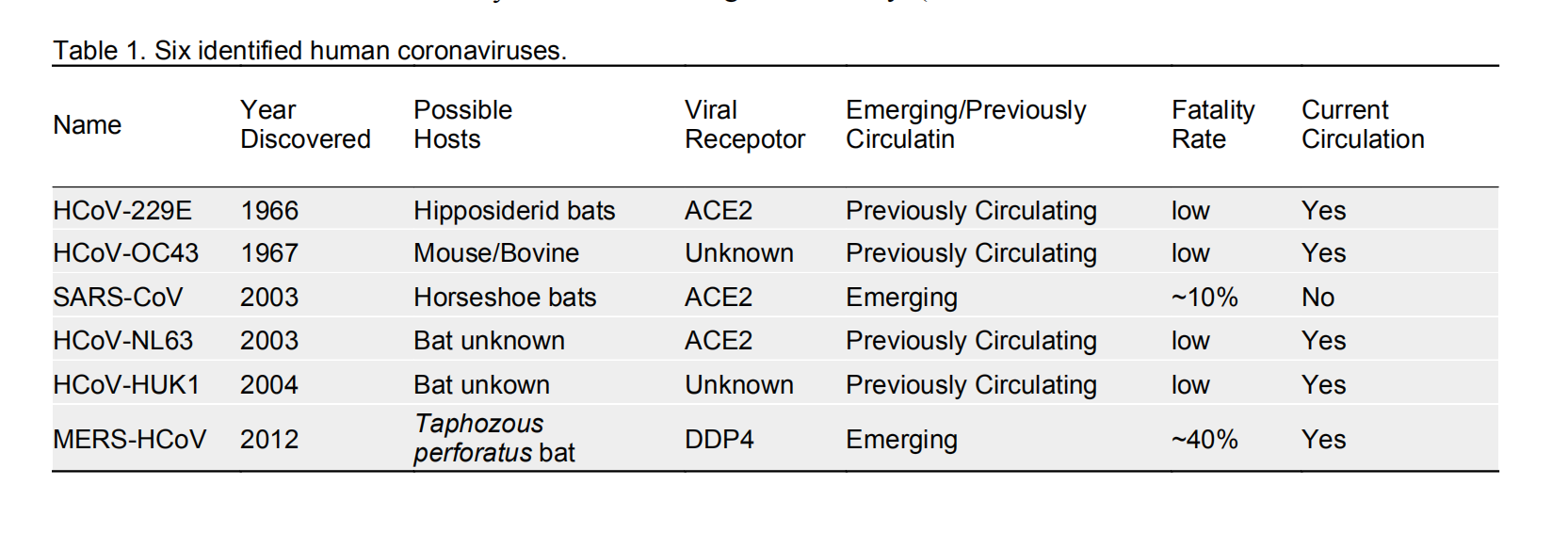 This manuscript was suggested to be re-organized, and considered to be published in the form of “perspective”. It’s suggested to be organized into four parts: Brief introduction of CoVs; prevalence of six human CoVs (especially the cases about the global transmission); the zoonotic origin; control & prevention. The “One health” concept(one earth, one world, one health)can be emphasized throughout this article. The One Health approach emphasizes the relatedness of human, animal, and environmental health and the importance of transdisciplinary efforts. The One Health approach integrat human, animal, and environmental health and such integration could improve disease prediction and control efforts.
This manuscript was suggested to be re-organized, and considered to be published in the form of “perspective”. It’s suggested to be organized into four parts: Brief introduction of CoVs; prevalence of six human CoVs (especially the cases about the global transmission); the zoonotic origin; control & prevention. The “One health” concept(one earth, one world, one health)can be emphasized throughout this article. The One Health approach emphasizes the relatedness of human, animal, and environmental health and the importance of transdisciplinary efforts. The One Health approach integrat human, animal, and environmental health and such integration could improve disease prediction and control efforts. -
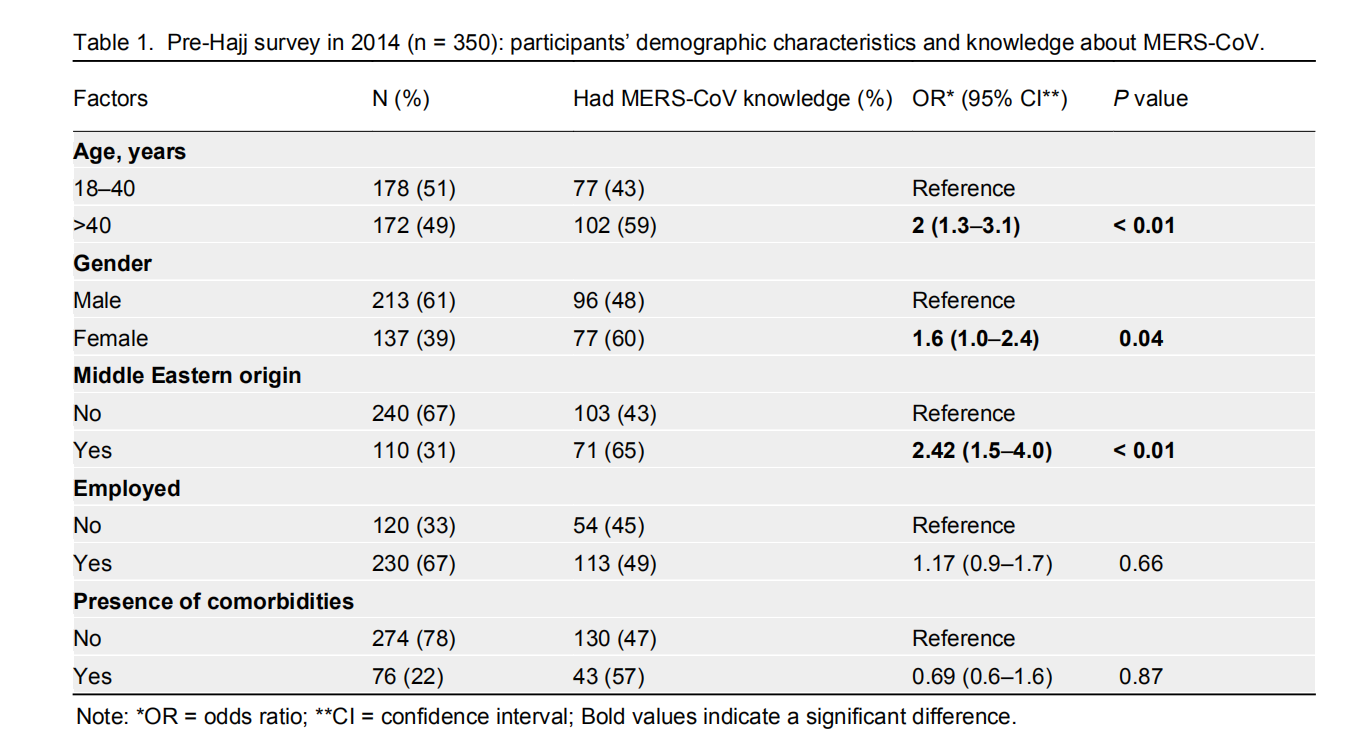
Camel exposure and knowledge about MERS-CoV among Australian Hajj pilgrims in 2014
2016, 31(1): 89 doi: 10.1007/s12250-015-3669-1
出版日期: 2016-01-18In this study, the authors evaluated Australian pilgrims’ knowledge and perceptions regarding the risk of MERS-CoV and camel contact at Hajj. Moreover, the authors assessed their practice regarding contact with camels during Hajj. This is the first study which has assessed the actual practice of the pilgrims’ contact with camels during Hajj. This study involved two cross-sectional surveys among Australian pilgrims aged ≥ 18 years, before and after Hajj in 2014. The first survey was conducted 1 month before Hajj among departing pilgrims. Participants were met at weekly pre-Hajj seminars run by travel agents and were invited to take part in the survey. The second survey was conducted immediately after the pilgrims’ return to Australia (post-Hajj study). Participants were recruited in selected Muslim suburbs during community gatherings in mosques or Islamic centres. In conclusion, many Australian Hajj pilgrims are not aware of MERS-CoV in Saudi Arabia, and some of them engage in activities that may put them at risk of MERS-CoV; therefore, there is a need for improved awareness among Hajj pilgrims and other travelers to the Middle East regarding MERS-CoV. -
 In this study, the authors developed a two-tube multiplex real-time RT-PCR assay for sensitive and specific detection of all known human coronaviruses. Its ability to monitor HKU1 replication in cultures of human airway epithelial cells, to quantitatively measure viral RNA in monkeys experimentally infected with MERS, and to detect MERS in a human patient was demonstrated. In addition, the assay was used to assess disease burden and epidemiology of coronaviruses among hospitalized patients with acute respiratory infection. The results indicate that the assay is quantitative, rapid, sensitive, specific, high-throughput, and able to detect co-infection. Finally, the assay requires significantly less sample than monoplex real-time RT-PCR.
In this study, the authors developed a two-tube multiplex real-time RT-PCR assay for sensitive and specific detection of all known human coronaviruses. Its ability to monitor HKU1 replication in cultures of human airway epithelial cells, to quantitatively measure viral RNA in monkeys experimentally infected with MERS, and to detect MERS in a human patient was demonstrated. In addition, the assay was used to assess disease burden and epidemiology of coronaviruses among hospitalized patients with acute respiratory infection. The results indicate that the assay is quantitative, rapid, sensitive, specific, high-throughput, and able to detect co-infection. Finally, the assay requires significantly less sample than monoplex real-time RT-PCR. -
To date, Middle East respiratory syndrome coronavirus (MERS-CoV) has affected over 1600 individuals in 26 countries across the globe, claiming 40% lives and thus poses a great public health challenge to the Middle East and elsewhere. Risk factors for mortality and severity among MERS patients are poorly understood. To address this, the author analysed a large dataset from Saudi Arabian Ministry of Health (MOH) in order to explore key risk factors for mortality and severity, and found that people with certain co-morbid conditions (diabetes, hypertension, renal disease, malignancy, miscellaneous conditions) were at particularly higher risk of dying or suffering severe outcome of MERS-CoV.
-
 In previous studies, the authors have found diverse SARS-like coronaviruses (SL-CoVs) in a single bat colony. To investigate the spatio-temporal dynamics of these viruses, a longitudinal surveillance of bat SL-CoV from a total of 431 bat fecal samples collected during 2011 to 2014 from the Yunnan in China using quantitative real-time PCR (qRT-PCR) by targeting the nucleocapsid (N) and RNA dependent RNA polymerase (RdRp) genes was conducted in this study. The authors demonstrated that the detection rate of the SL-CoV was higher during July to October providing useful information that might be helpful for surveillance of potential transmission of bats in the future.
In previous studies, the authors have found diverse SARS-like coronaviruses (SL-CoVs) in a single bat colony. To investigate the spatio-temporal dynamics of these viruses, a longitudinal surveillance of bat SL-CoV from a total of 431 bat fecal samples collected during 2011 to 2014 from the Yunnan in China using quantitative real-time PCR (qRT-PCR) by targeting the nucleocapsid (N) and RNA dependent RNA polymerase (RdRp) genes was conducted in this study. The authors demonstrated that the detection rate of the SL-CoV was higher during July to October providing useful information that might be helpful for surveillance of potential transmission of bats in the future. -

中国多种蝙蝠α和β冠状病毒的检测与鉴定
2016, 31(1): 69 doi: 10.1007/s12250-016-3727-3
收稿日期: 2016-01-15 录用日期: 2016-01-21 出版日期: 2016-02-02Bats have been implicated as important reservoir hosts of alpha- and betacoronaviruses. In this study, diverse coronaviruses (CoVs) were detected in 50 of 951 (positive rate 5.3%) intestinal specimens of eight bat species collected in four provinces and the Tibet Autonomous Region of China by pan-coronavirus RT-PCR screening. Based on 400-nt RNA-dependent RNA polymerase (RdRP) sequence analysis, eight belonged to genus Alphacoronavirus and 42 to Betacoronavirus. Among the 50 positive specimens, thirteen gave rise to CoV full-length RdRP gene amplification for further sequence comparison, of which three divergent sequences (two from a unreported province) were subjected to full genome sequencing. Two complete genomes of betacoronaviruses (JTMC15 and JPDB144) and one nearly-complete genome of alphacoronavirus (JTAC2) were sequenced and their genomic organization predicted. The present study has identified additional numbers of genetically diverse bat-borne coronaviruses with a wide distribution in China. Two new species of bat CoV, identified through sequence comparison and phylogenetic analysis, are proposed. -
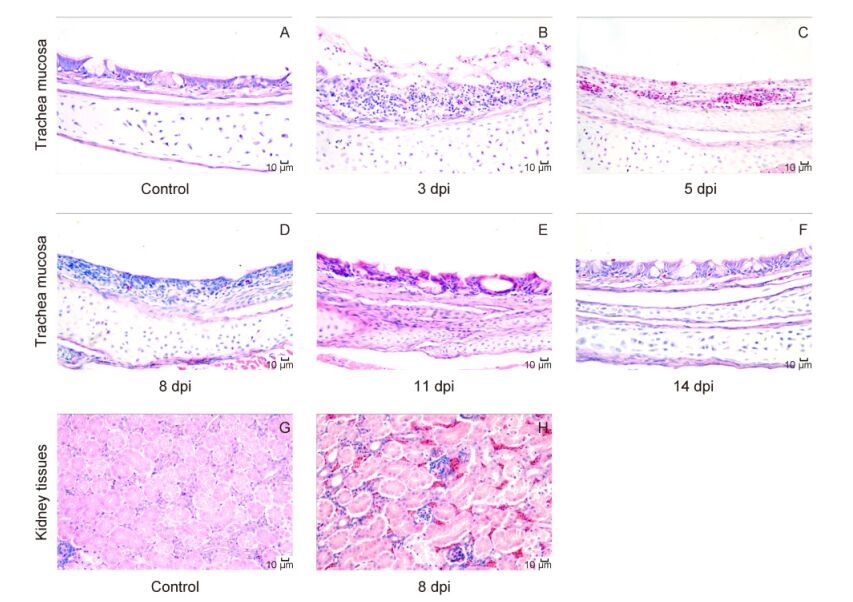
鸡传染性支气管炎病毒感染雏鸡引起的TLR和MDA5信号通路应答
2016, 31(1): 57 doi: 10.1007/s12250-015-3696-y
收稿日期: 2015-12-01 录用日期: 2016-01-27 出版日期: 2016-02-19Avian infectious bronchitis virus (IBV) is a Gammacoronavirus in the family Coronaviridae and causes highly contagious respiratory disease in chickens. Innate immunity plays significant roles in host defense against IBV. Here, we explored the interaction between IBV and the host innate immune system. Severe histopathological lesions were observed in the tracheal mucosa at 3–5 days post inoculation (dpi) and in the kidney at 8 dpi, with heavy viral loads at 1–11 and 1–28 dpi, respectively. The expression of mRNAs encoding Toll-like receptor (TLR) 3 and TLR7 were upregulated at 3–8 dpi, and that of TIR-domain-containing adapter-inducing interferon (IFN) β (TRIF) was upregulated at 21 dpi in the trachea and kidney. Myeloid differentiation primary response protein 88 (MyD88) was upregulated in the trachea during early infection. Tumor necrosis factor receptor-associated factor (TRAF) 3 and TRAF6 were upregulated expression in both tissues. Moreover, melanoma differentiation-associated protein 5 (MDA5), laboratory of genetics and physiology 2 (LGP2), stimulator of IFN genes (STING), and mitochondrial antiviral signaling protein (MAVS), as well as TANK binding kinase 1 (TBK1), inhibitor of kappaB kinase (IKK) ?, IKKα, IKKβ, IFN regulatory factor (IRF) 7, nuclear factor of kappaB (NF-κB), IFN-α, IFN-β, various interleukins(ILs), and macrophage inflammatory protein-1β (MIP-1β) were significantly upregulated in the trachea and downregulated in the kidney. These results suggested that the TLR and MDA5 signaling pathways and innate immune cytokine were induced after IBV infection. Additionally, consistent responses to IBV infection were observed during early infection, with differential and complicated responses in the kidney. -
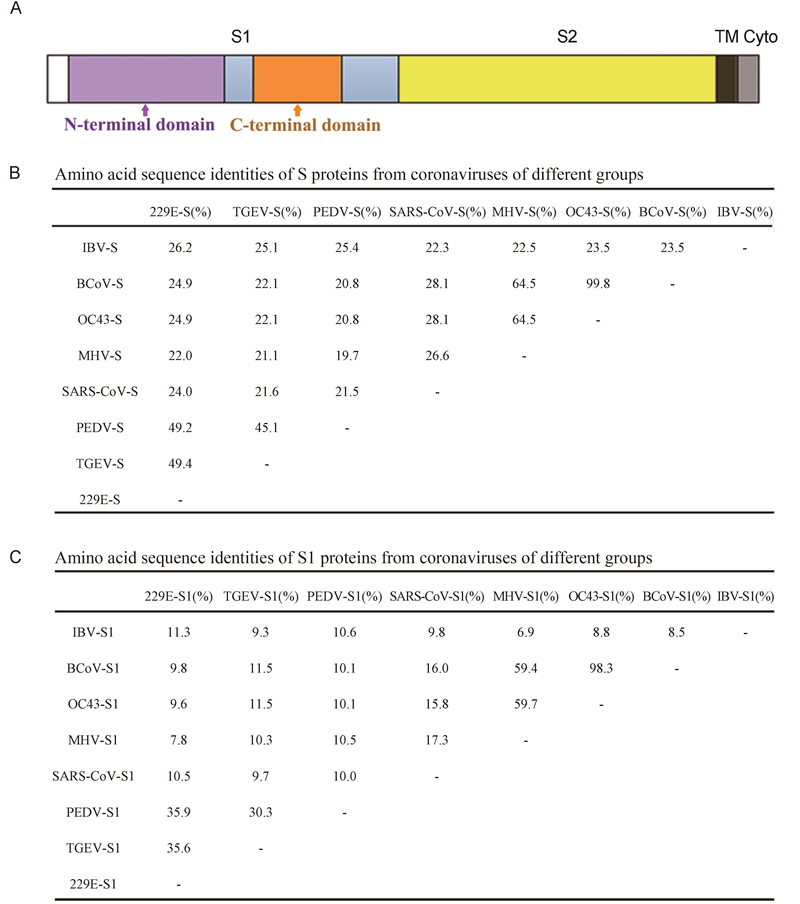
冠状病毒S蛋白慢病毒假型的比较及猪冠状病毒的细胞趋性
2016, 31(1): 49 doi: 10.1007/s12250-015-3690-4
收稿日期: 2015-11-26 录用日期: 2016-01-28 出版日期: 2016-02-19The surface glycoproteins of coronaviruses play an important role in receptor binding and cell entry. Different coronaviruses interact with their specific receptors to enter host cells. Lentiviruses pseudotyped with their spike proteins (S) were compared to analyze the entry efficiency of various coronaviruses. Our results indicated that S proteins from different coronaviruses displayed varied abilities to mediate pseudotyped virus infection. Furthermore, the cell tropisms of porcine epidemic diarrhea virus (PEDV) and transmissible gastroenteritis virus (TGEV) have been characterized by live and pseudotyped viruses. Both live and pseudoviruses could infected Vero- CCL-81 (monkey kidney), Huh-7 (human liver), and PK-15 (pig kidney) cells efficiently. CCL94 (cat kidney) cells could be infected efficiently by TGEV but not PEDV. Overall, our study provides new insights into the mechanisms of viral entry and forms a basis for antiviral drug screening. -
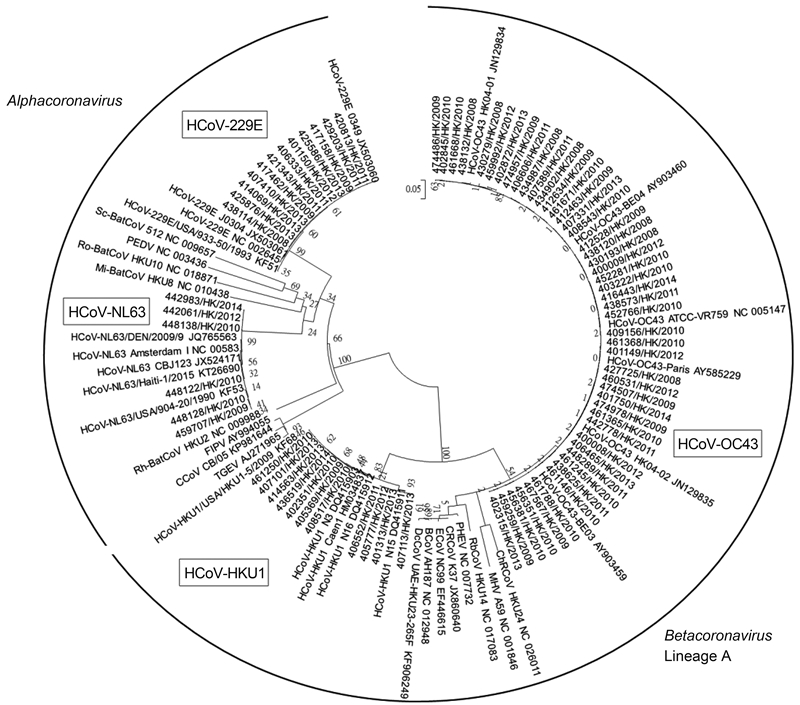
A six-year descriptive epidemiological study of human coronavirus infections in hospitalized patients in Hong Kong
2016, 31(1): 41 doi: 10.1007/s12250-016-3714-8
收稿日期: 2016-01-04 录用日期: 2016-02-11 出版日期: 2016-02-23We conducted a six-year epidemiological study on human coronaviruses (HCoVs) circulating in Hong Kong, using 8275 nasopharyngeal samples from patients with acute respiratory tract infections. HCoVs were detected in 77 (0.93%) of the samples by a pan-HCoV RT-PCR assay. The most frequently detected HCoV species was HCoV-OC43 (0.58%), followed by HCoV-229E (0.15%), HCoV-HKU1 (0.13%) and HCoV-NL63 (0.07%). HCoVs were detected throughout the study period (September 2008–August 2014), with the highest detection rate from September 2010 to August 2011 (22/1500, 1.47%). Different seasonal patterns of each HCoV species in Hong Kong were noted. HCoV-OC43 was predominant in the fall and winter, whereas HCoV-HKU1 showed peak activity in winter, with a few cases occurred in spring and summer. HCoV-229E mainly occurred in winter and spring, while HCoV-NL63 was predominant in summer and autumn. HCoVs most commonly infect the elderly and young children, with median age of 79.5 years (range, 22 days to 95 years). Intriguingly, the detection rate of HCoV-OC43 in the age group of > 80 years (26/2380, 1.09%) was significantly higher than that in the age group of 0–10 years (12/2529, 0.47%) (P < 0.05). These data provides new insight into the epidemiology of coronaviruses. -

一个废弃矿洞中检测到多种蝙蝠冠状病毒
2016, 31(1): 31 doi: 10.1007/s12250-016-3713-9
收稿日期: 2016-01-01 录用日期: 2016-01-22 出版日期: 2016-02-18Since the 2002–2003 severe acute respiratory syndrome (SARS) outbreak prompted a search for the natural reservoir of the SARS coronavirus, numerous alpha- and betacoronaviruses have been discovered in bats around the world. Bats are likely the natural reservoir of alpha- and betacoronaviruses, and due to the rich diversity and global distribution of bats, the number of bat coronaviruses will likely increase. We conducted a surveillance of coronaviruses in bats in an abandoned mineshaft in Mojiang County, Yunnan Province, China, from 2012–2013. Six bat species were frequently detected in the cave: Rhinolophus sinicus, Rhinolophus affinis, Hipposideros pomona, Miniopterus schreibersii, Miniopterus fuliginosus, and Miniopterus fuscus. By sequencing PCR products of the coronavirus RNA-dependent RNA polymerase gene (RdRp), we found a high frequency of infection by a diverse group of coronaviruses in different bat species in the mineshaft. Sequenced partial RdRp fragments had 80%–99% nucleic acid sequence identity with well-characterized Alphacoronavirus species, including BtCoV HKU2, BtCoV HKU8, and BtCoV1, and unassigned species BtCoV HKU7 and BtCoV HKU10. Additionally, the surveillance identified two unclassified betacoronaviruses, one new strain of SARS-like coronavirus, and one potentially new betacoronavirus species. Furthermore, coronavirus co-infection was detected in all six bat species, a phenomenon that fosters recombination and promotes the emergence of novel virus strains. Our findings highlight the importance of bats as natural reservoirs of coronaviruses and the potentially zoonotic source of viral pathogens. -
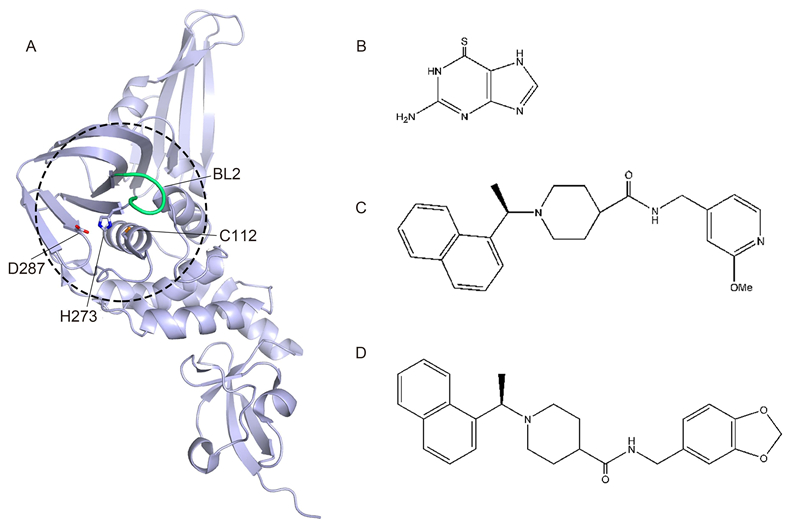
冠状病毒蛋白酶抑制剂的研发进展
2016, 31(1): 24 doi: 10.1007/s12250-015-3711-3
收稿日期: 2015-12-29 录用日期: 2016-01-22 出版日期: 2016-02-19Coronaviruses (CoVs) can cause highly prevalent diseases in humans and animals. The fatal outbreak of severe acute respiratory syndrome (SARS) and Middle East respiratory syndrome (MERS) highlights the threat posed by this unique virus subfamily. However, no specific drugs have been approved to treat CoV-associated diseases to date. The CoV proteases, which play pivotal roles in viral gene expression and replication through a highly complex cascade involving the proteolytic processing of replicase polyproteins, are attractive targets for drug design. This review summarizes the recent advances in biological and structural studies, together with the development of inhibitors targeting CoV proteases, particularly main proteases (Mpros), which could help develop effective treatments to prevent CoV infection. -
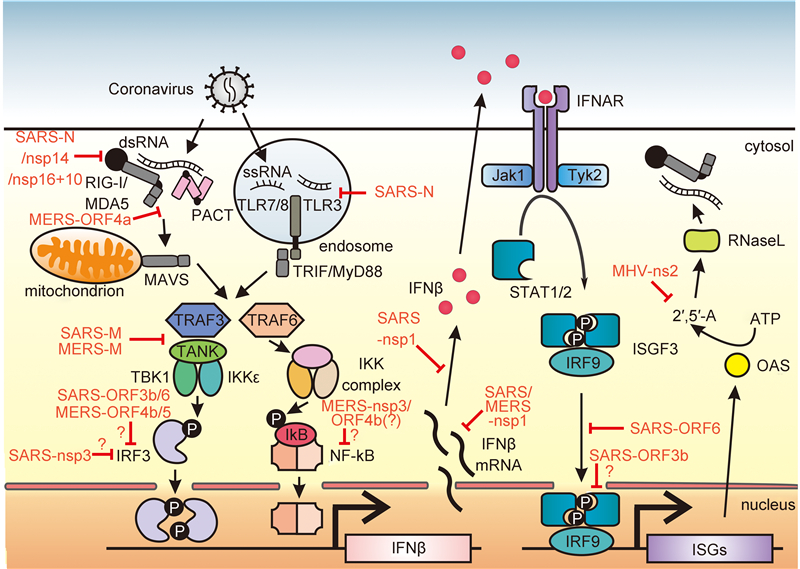
人类新发冠状病毒与宿主固有抗病毒反应之间的分子军备竞赛
2016, 31(1): 12 doi: 10.1007/s12250-015-3683-3
收稿日期: 2015-11-21 录用日期: 2016-01-07 出版日期: 2016-01-15Coronaviruses have been closely related with mankind for thousands of years. Communityacquired human coronaviruses have long been recognized to cause common cold. However, zoonotic coronaviruses are now becoming more a global concern with the discovery of highly pathogenic severe acute respiratory syndrome (SARS) and Middle East respiratory syndrome (MERS) coronaviruses causing severe respiratory diseases. Infections by these emerging human coronaviruses are characterized by less robust interferon production. Treatment of patients with recombinant interferon regimen promises beneficial outcomes, suggesting that compromised interferon expression might contribute at least partially to the severity of disease. The mechanisms by which coronaviruses evade host innate antiviral response are under intense investigations. This review focuses on the fierce arms race between host innate antiviral immunity and emerging human coronaviruses. Particularly, the host pathogen recognition receptors and the signal transduction pathways to mount an effective antiviral response against SARS and MERS coronavirus infection are discussed. On the other hand, the counter-measures evolved by SARS and MERS coronaviruses to circumvent host defense are also dissected. With a better understanding of the dynamic interaction between host and coronaviruses, it is hoped that insights on the pathogenesis of newly-identified highly pathogenic human coronaviruses and new strategies in antiviral development can be derived. -
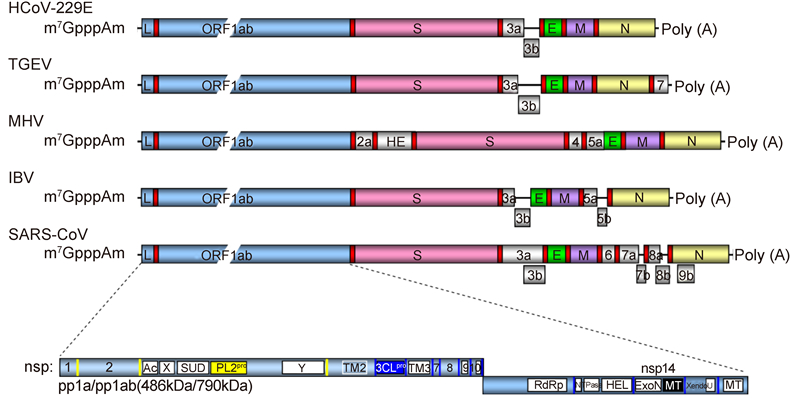
冠状病毒RNA加帽及甲基化修饰的分子机制
2016, 31(1): 3 doi: 10.1007/s12250-016-3726-4
收稿日期: 2016-01-15 录用日期: 2016-01-25 出版日期: 2016-02-02The 5′-cap structures of eukaryotic mRNAs are important for RNA stability, pre-mRNA splicing, mRNA export, and protein translation. Many viruses have evolved mechanisms for generating their own cap structures with methylation at the N7 position of the capped guanine and the ribose 2′-Oposition of the first nucleotide, which help viral RNAs escape recognition by the host innate immune system. The RNA genomes of coronavirus were identified to have 5′-caps in the early 1980s. However, for decades the RNA capping mechanisms of coronaviruses remained unknown. Since 2003, the outbreak of severe acute respiratory syndrome coronavirus has drawn increased attention and stimulated numerous studies on the molecular virology of coronaviruses. Here, we review the current understanding of the mechanisms adopted by coronaviruses to produce the 5′- cap structure and methylation modification of viral genomic RNAs. -
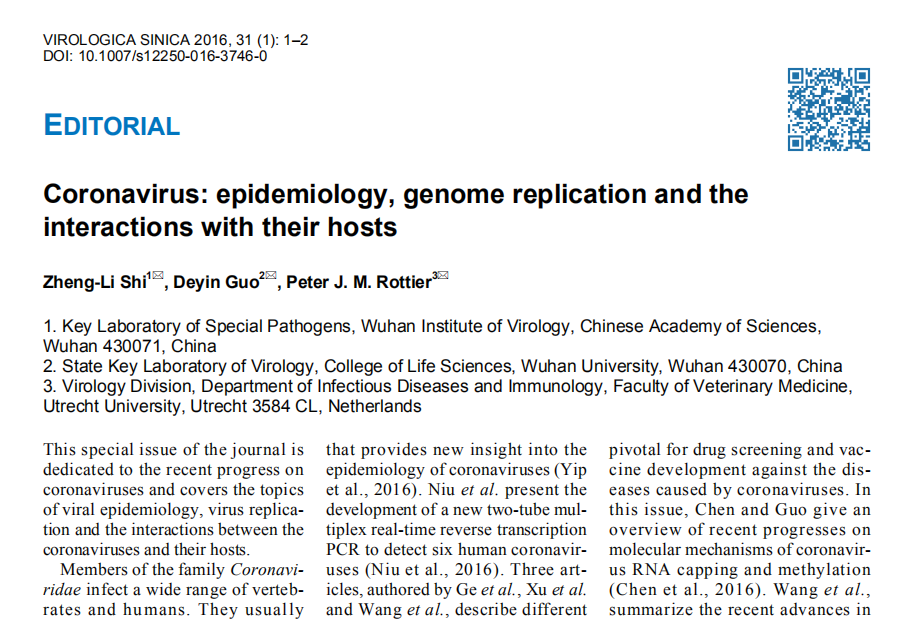
Coronavirus: epidemiology, genome replication and the interactions with their hosts
2016, 31(1): 1 doi: 10.1007/s12250-016-3746-0
出版日期: 2016-02-19This special issue of the journal is dedicated to the recent progress on coronaviruses and covers the topics of viral epidemiology, virus replication and the interactions between the coronaviruses and their hosts.
- [01/11]《中国病毒学(英文)》期刊编辑部招聘启事
- [05/07]Q1区!VS最新影响因子5.5!
- [22/02]2022年VS高被引论文奖发布
- [21/10]第十届新生病毒性疾病控制学术研讨会 | 第一轮通知
- [09/09]肝癌细胞中CK1α上调IFNAR1的表达,从而促进I型IFN抑制HBV复制
- [09/09]一种新的干扰素诱导的长非编码RNA ZAP-IT1阻断寨卡病毒在A549细胞中的复制
- [09/09]首发精神分裂症中,驯化的人内源性逆转录病毒W家族包膜蛋白通过降低5-HT4受体的水平激活SK2
- [09/09]发热伴血小板减少综合征病毒L蛋白功能域和保守残基研究为理解病毒RNA转录/复制机制提供新思路
- [09/09]亲环素A结合AKT1并通过介导AKT/mTOR/NF-κB正反馈环路的激活促进EB病毒的致瘤作用 | VS推荐
- [09/09]转录组分析显示克里米亚刚果出血热病毒调控的关键细胞过程及III型干扰素的抗病毒作用 | VS推荐







